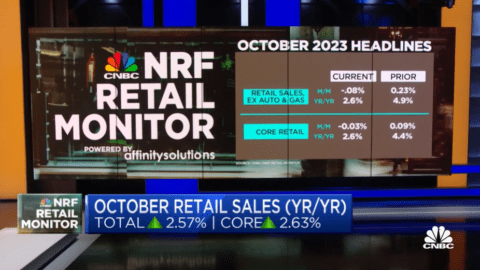[Editor’s Note: This story was updated on Dec. 4, 2024 to include Cyber Monday and full Cyber Week results.]
Easing inflation, the looming threat of potential tariffs and heavy discounting saw Americans spend in record numbers over the Thanksgiving weekend, racking up $76 billion in sales in the U.S., a 7% increase over 2023, according to Salesforce. Over the five-day shopping period from Thanksgiving through Cyber Monday, the National Retail Federation estimates that 197 million American shoppers turned out, surpassing initial expectations.
“Thanksgiving weekend retains its prominence among holiday spending events and continues to play a significant role in the holiday season for both consumers and retailers,” said Matthew Shay, NRF President and CEO in a statement. “Even with this year’s shortened shopping period and the multitude of early sales promotions from retailers, this past weekend exceeded expectations in terms of the sheer volume of shoppers.”
While Black Friday remains the most popular day for both in-store and online shopping, according to the NRF survey, Cyber Monday broke sales records as the biggest online shopping day of all time, based on sales figures from Adobe Analytics.
The top shopping destinations throughout the weekend included department stores (42%), online (42%), grocery stores and supermarkets (40%), clothing and accessories stores (37%) and discount stores (32%), according to the NRF survey. The NRF expects spending during the full holiday period (from Nov. 1 to Dec. 31) to reach record levels this year, growing between 2.5% and 3.5% over 2023 for a total of $979.5 billion to $989 billion.
Cyber Monday 2024 Becomes Biggest Online Shopping Day of All Time
Banner sales on Cyber Monday, driven largely by that day’s heavy discounting, signal that inflation-weary shoppers are willing to spend — but also are intently focused on getting the best value for their money.
Adobe figures put U.S. spending on the day at $13.3 billion (up 7.3% YoY), while Salesforce figures, which rely on different methodology, put total Cyber Monday sales at $12.8 billion in the U.S. (up 2% YoY) — record-breaking numbers however you cut it.
Black Friday Remains a Shopping Stronghold
U.S. retail sales on Black Friday (excluding automotive) were up 3.4%, according to Mastercard SpendingPulse, which measures in-store and online retail sales across all payment types. Online sales saw an even bigger bump, with Adobe reporting a new milestone for ecommerce on Black Friday as consumers spent a record $10.8 billion online, up 10.2% YoY. That is more than double what consumers spent just a few years ago in 2017, when Black Friday drove a little over $5 billion in online spend. Salesforce reported an even higher Black Friday sales number of $17.5 billion in U.S. online sales, a 7% year-over-year increase.
Significant Discounts Helped Boost Sales
“Black Friday was a good indicator of how the holiday season is positively shaping up,” said Michelle Meyer, Chief Economist for the Mastercard Economics Institute in a statement. “Our real-time insights show that consumers are comfortably in the gift-giving spirit as price reductions and deals occur across sectors, supporting budgets for holiday shopping.”
Home appliances, dining and furniture (+17%), general footwear and handbags (+13%) and general apparel (+10%) were the categories showing the highest growth rates on Black Friday in the U.S., according to Salesforce, while verticals with the highest average discount rate included general apparel (37% average discount), health and beauty (36% average) and home goods (27% average).
“Just as we predicted, bargain hunters held out for Black Friday to snag those big-ticket items,” said Caila Schwartz, Director of Consumer Insights at Salesforce in a statement. “Our data revealed that luxury handbags and home appliances — categories with heftier price tags — were the stars of the show, even with modest discounts. It’s clear that consumers saw Cyber Week as the ultimate splurge season.”
Despite discounting throughout the weekend, Black Friday still remained the biggest sales day of the period. Shopify data aggregated across that platform’s millions of merchants indicated that Noon Eastern on Friday, Nov. 29 was the peak sales hour.
Additionally, marketing platform Bluecore found that 64% of all 2024 Black Friday shoppers were new to retailers, indicating that retailers’ seasonal customer acquisition efforts are paying off. “Considering the skyrocketing costs of new customer acquisition, retailers who can identify shoppers and turn one-time buyers into repeat customers will ultimately spend less to make more,” said Jason Grunberg, Chief Marketing Officer of Bluecore in a statement. “And now they have 64% more customers they can target with this goal in mind.”
Online Shopping Continues its Shift Toward Mobile
Consumers also continued to shift their online shopping to mobile devices, a trend that has been steadily growing for the past several years. Salesforce reported that 80% of global traffic came from mobile devices on Black Friday, with mobile devices driving 69% of all orders, up from 68% in 2023. Adobe noted a similar trend, and Salesforce indicated that the increase in consumers actually completing transactions on their phones was likely due to the growing prevalence of mobile wallets, which grew 41% YoY.
AI Shopping Assistants Make a Big Entrance
Both Salesforce and Adobe also noted the emerging influence of generative AI-powered chatbots. Salesforce reported that AI and AI agents drove $14.1 billion in online sales on Black Friday globally as usage of Gen AI features bumped up 6% week over week on that day and the usage of AI-enabled online chat services grew 31% year over year. Additionally, traffic to retail sites from chatbots on Black Friday increased by 1,800% compared to Black Friday last year, according to Adobe.
“By harnessing the value of AI and agentic conversations, retailers are better equipped to serve the needs of their shoppers and drive them to the ‘buy’ button,” said Salesforce’s Schwartz. “Digital retailers that are using generative AI and agents in their customer service experiences saw a 9% higher conversion rate compared to those who are not. For an industry that is often concerned with margins, especially ahead of rising costs in 2025, this percent increase is a game-changer.”
Foot Traffic Falls as Consumers Set New Ecommerce Record
Banner online sales over the holiday weekend did come at the expense of in-store shopping. Data from in-store traffic analytics provider RetailNext found that store foot traffic decreased 3.2% on Black Friday and 0.8% on Saturday, for a Friday/Saturday average overall decrease of 1.9%.
“The extended shopping period has ultimately decreased the singular importance of Black Friday itself,” said Joe Shasteen, Global Head of Advanced Analytics at RetailNext in a statement. “Categories like apparel, footwear and jewelry saw notable traffic increases on the Saturday following Black Friday, indicating that consumers are spreading out their purchases. These trends show a shift in shopping behavior, with extended promotions allowing for more flexibility and reducing reliance on Black Friday as the primary shopping day.
“While foot traffic remains a cornerstone for measuring offline performance, today’s shoppers are increasingly expecting a seamless experience across all channels,” Shasteen added. “Retailers who successfully connect their physical stores with digital platforms will be better positioned to capture value this holiday season and beyond.”
Indeed, preliminary sales figures show a general trend toward online purchasing during these major sales periods, especially Black Friday, given that consumers may still have negative connotations from the crowded stores of Black Fridays past. Some of the biggest holiday gifting categories saw huge online sales growth this weekend, according to Adobe, including toys (online sales up 622% from the October 2024 average), jewelry (online sales up 561%), appliances (up 476%), personal care (up 440%), apparel (up 374%) and electronics (up 334%).
“Crossing the $10 billion mark is a big ecommerce milestone for Black Friday, for a day that in the past was more anchored toward in-store shopping,” said Vivek Pandya, Lead Analyst at Adobe Digital Insights in a statement. “And with consumers getting more comfortable with everything from mobile shopping to chatbots, we have tailwinds that can prop up online growth for Black Friday moving forward.”
Looking Ahead to Cyber Monday
There’s still one day left in the five-day Thanksgiving weekend sales bonanza — Cyber Monday — and experts are widely expecting banner sales to continue. Salesforce predicts that Cyber Monday will drive $51 billion in global sales and $13.5 billion in the U.S., up from 2023’s $48.4 billion globally and $12.6 billion in the U.S. And Adobe expects Cyber Monday to be the biggest shopping day for online sales not just this holiday season, but for the whole year, driving a record $13.2 billion in spend, up 6.1% year over year.













